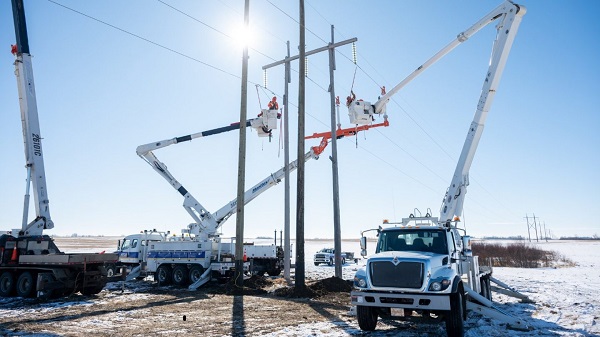Alberta
Alberta power outages and higher costs on the way with new federal electricity regulations, AESO says

From the Canadian Energy Centre
By Cody Ciona
Clean Electricity Regulations put Alberta grid at risk for ‘minimal emissions reductions’
Alberta is at risk of power outages by the mid-2030s as a result of the federal government’s Clean Electricity Regulations (CER), says a new report by the Alberta Electric System Operator (AESO).
The AESO’s analysis found the new regulations, which came into effect on January 1, will make the province’s electricity system more than 100 times less reliable by 2038.
Alberta has already reduced emissions from electricity production by 59 per cent since 2005 without the CER, according to the federal government’s national emissions reporting.
The finalized CER in December 2024 pushed out the federal government’s target of a net zero power grid from 2035 to 2050, but the AESO said the costs of the regulation continue to outweigh its minimal environmental benefit.
The CER essentially mandates the rapid and widespread adoption of technologies that remain under development or have not been commercially tested in Alberta, the AESO said.
This includes nuclear, large-scale hydroelectric generation, natural gas generation with carbon capture and storage, and hydrogen generation.
Due to restrictions on natural gas generation, the AESO forecasts an additional $30 billion in capital and operational costs between now and 2049.
The regulations will have high costs for Albertans, increasing wholesale electricity prices by 35 per cent above what they otherwise would be, the AESO said.
Along with potential reliability and affordability issues, the regulations will result in less than one million tonnes of emissions reduced annually, according to AESO.
“The significant cost that the CER will impose on Alberta’s electricity system for minimal emissions reductions means the regulation is inefficient and ineffective,” the AESO said.
“The threat to reliability resulting from the CER means that the regulation puts Alberta’s electricity grid at significant risk for little to no benefit.”
Alberta
Temporary Alberta grid limit unlikely to dampen data centre investment, analyst says
From the Canadian Energy Centre
By Cody Ciona
‘Alberta has never seen this level and volume of load connection requests’
Billions of investment in new data centres is still expected in Alberta despite the province’s electric system operator placing a temporary limit on new large-load grid connections, said Carson Kearl, lead data centre analyst for Enverus Intelligence Research.
Kearl cited NVIDIA CEO Jensen Huang’s estimate from earlier this year that building a one-gigawatt data centre costs between US$60 billion and US$80 billion.
That implies the Alberta Electric System Operator (AESO)’s 1.2 gigawatt temporary limit would still allow for up to C$130 billion of investment.
“It’s got the potential to be extremely impactful to the Alberta power sector and economy,” Kearl said.
Importantly, data centre operators can potentially get around the temporary limit by ‘bringing their own power’ rather than drawing electricity from the existing grid.
In Alberta’s deregulated electricity market – the only one in Canada – large energy consumers like data centres can build the power supply they need by entering project agreements directly with electricity producers.
According to the AESO, there are 30 proposed data centre projects across the province.
The total requested power load for these projects is more than 16 gigawatts, roughly four gigawatts more than Alberta’s demand record in January 2024 during a severe cold snap.
For comparison, Edmonton’s load is around 1.4 gigawatts, the AESO said.
“Alberta has never seen this level and volume of load connection requests,” CEO Aaron Engen said in a statement.
“Because connecting all large loads seeking access would impair grid reliability, we established a limit that preserves system integrity while enabling timely data centre development in Alberta.”
As data centre projects come to the province, so do jobs and other economic benefits.
“You have all of the construction staff associated; electricians, engineers, plumbers, and HVAC people for all the cooling tech that are continuously working on a multi-year time horizon. In the construction phase there’s a lot of spend, and that is just generally good for the ecosystem,” said Kearl.
Investment in local power infrastructure also has long-term job implications for maintenance and upgrades, he said.
“Alberta is a really exciting place when it comes to building data centers,” said Beacon AI CEO Josh Schertzer on a recent ARC Energy Ideas podcast.
“It has really great access to natural gas, it does have some excess grid capacity that can be used in the short term, it’s got a great workforce, and it’s very business-friendly.”
The unaltered reproduction of this content is free of charge with attribution to the Canadian Energy Centre.
Alberta
Alberta Next: Taxation

A new video from the Alberta Next panel looks at whether Alberta should stop relying on Ottawa to collect our provincial income taxes. Quebec already does it, and Alberta already collects corporate taxes directly. Doing the same for personal income taxes could mean better tax policy, thousands of new jobs, and less federal interference. But it would take time, cost money, and require building new systems from the ground up.
-

 Business1 day ago
Business1 day agoCarney government should apply lessons from 1990s in spending review
-

 Business2 days ago
Business2 days agoTrump to impose 30% tariff on EU, Mexico
-

 Entertainment1 day ago
Entertainment1 day agoStudy finds 99% of late-night TV guests in 2025 have been liberal
-

 illegal immigration2 days ago
illegal immigration2 days agoICE raids California pot farm, uncovers illegal aliens and child labor
-

 Business7 hours ago
Business7 hours agoMark Carney’s Fiscal Fantasy Will Bankrupt Canada
-

 Frontier Centre for Public Policy20 hours ago
Frontier Centre for Public Policy20 hours agoCanada’s New Border Bill Spies On You, Not The Bad Guys
-

 Energy2 days ago
Energy2 days agoLNG Export Marks Beginning Of Canadian Energy Independence
-

 Uncategorized20 hours ago
Uncategorized20 hours agoCNN’s Shock Climate Polling Data Reinforces Trump’s Energy Agenda



